
Are you on the hunt for a natural skincare ingredient that can work wonders on dark spots and uneven skin tone? If yes, aloe vera might just be the solution you’re looking for. Many of us have dealt with hyperpigmentation at some point, and it can feel discouraging when those stubborn dark patches linger. But here’s the good news: aloe vera, a plant known for its soothing properties, is a simple remedy, which can help reduce hyperpigmentation naturally.
Table of Content:-

Aloe vera is a succulent plant that has been used for centuries for its medicinal and skin benefits. Its gel contains several bioactive compounds, such as vitamins, enzymes, minerals, sugars, amino acids, and salicylic acid. These components make it an excellent remedy for various skin conditions, including hyperpigmentation.
How Does Aloe Vera Reduce Hyperpigmentation
1. Inhibits Melanin Production

The primary cause of hyperpigmentation is the overproduction of melanin, a natural pigment that gives skin its colour. Melanin overproduction can be triggered by various factors, including sun damage and inflammation. A study published in Planta Medica suggests that aloesin (also known as aloin), an active compound found in aloe vera, may help reduce skin pigmentation. This was observed in research involving tadpole cells, highlighting aloesin's potential to lighten dark spots by inhibiting the production of melanin, the pigment responsible for skin colour.
2. Soothes and Heals Damaged Skin
Aloe vera is well known for its soothing properties, especially for irritated and inflamed skin. In the case of hyperpigmentation, it helps by calming skin inflammation and reducing any associated redness. The plant’s cooling gel is packed with antioxidants like vitamins A, C, and E, which help repair sun-damaged skin, a common cause of dark spots. Several older peer-reviewed studies have provided evidence suggesting that aloe vera can aid in the healing of first- and second-degree burns, including mild to moderate sunburns.
Also Read: Mulethi For Reducing Dark Spots: Expert Explains How It Reduce Hyperpigmentation And How To Use It
3. Natural Exfoliant

Aloe vera acts as a natural exfoliant due to the presence of salicylic acid, which gently lifts away dead skin cells. This mild exfoliation reveals the fresh, healthy skin underneath and can gradually fade dark spots. With regular use, it not only helps smooth your skin but also allows its healing ingredients to work more effectively, making it a simple yet powerful way to keep your skin looking bright and even-toned.
How to Use Aloe Vera for Hyperpigmentation
Using aloe vera to treat hyperpigmentation is simple and safe for most skin types. Here are a few methods to incorporate it into your skincare routine:
1. Aloe Vera Gel Application

The easiest method is to apply fresh aloe vera gel directly to the darkened areas of the skin. You can extract the gel from an aloe vera leaf and gently massage it into the affected areas. After about 20 minutes, rinse it off with lukewarm water. For optimal effects, repeat this procedure twice a day.
2. Aloe Vera and Lemon Juice
Lemon juice contains vitamin C, a natural skin brightener, and can be combined with aloe vera for added benefits. Start by mixing a teaspoon of lemon juice with two tablespoons of aloe vera gel and applying it to the pigmented areas. However, lemon juice can make your skin more sensitive to sunlight, so ensure you apply sunscreen afterward.
Also Read: Dark Patches On Skin? It Could Be Hyperpigmentation. Know What It Is
3. Aloe Vera and Turmeric Mask
Turmeric is known for its skin-lightening properties and, when combined with aloe vera, can be a powerful remedy for hyperpigmentation. Mix a tablespoon of aloe vera gel with a pinch of turmeric and apply the mixture to your face. Rub it in for 20 minutes before rinsing. This mask can help brighten the skin and reduce dark spots over time.
4. Aloe Vera and Honey
Honey is a natural humectant that moisturises the skin while also providing healing properties. Mixing aloe vera gel with honey can help lighten hyperpigmentation and improve overall skin texture. Apply the mixture to your skin and let it sit for about 20 minutes before rinsing off.
[Disclaimer: This article contains information for informational purposes only, hence, we advise you to consult your own professional if you are dealing with any health issues to avoid complications.]
Also watch this video
How we keep this article up to date:
We work with experts and keep a close eye on the latest in health and wellness. Whenever there is a new research or helpful information, we update our articles with accurate and useful advice.
Current Version